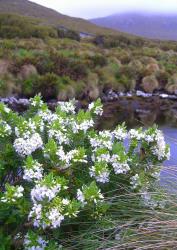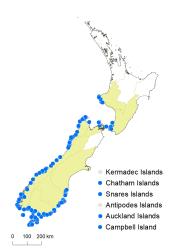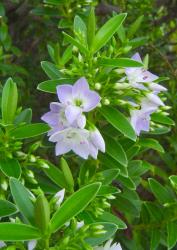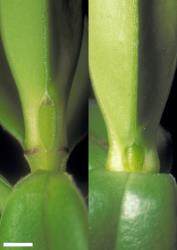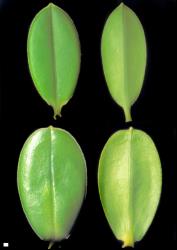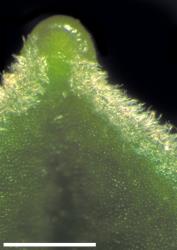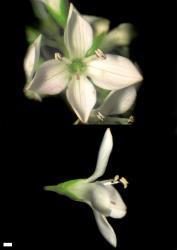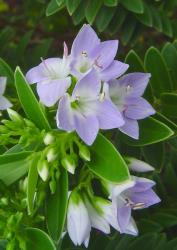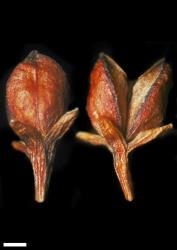- ≡ Veronica forsteri F.Muell., Veg. Chatham Isl. 45 (1864) nom. illeg.
- ≡ Hebe elliptica (G.Forst.) Pennell, Rhodora 23: 39 (1921)
- = Veronica decussata Moench, Verz. Ausländ. Bäume 137 (1785) nom. rej.
- = Veronica decussata Aiton, Hortus Kew. [W. Aiton] 1, 20 (1789) nom. illeg., non Veronica decussata Moench 1785
- = Hebe magellanica J.F.Gmel., Syst. Nat., ed. 13[bis] 27 (1791)
- = Veronica simpsonii Phil., Anales Univ. Chile 43: 526 (1873)
- = Veronica marginata Colenso, Trans. & Proc. New Zealand Inst. 28: 608 (1896)
- = Hebe elliptica var. crassifolia Cockayne & Allan, Trans. New Zealand Inst. 57: 27 (1926)
Bushy shrub to 2 m tall. Stems erect or sometimes spreading, eglandular-pubescent, hairs bifarious to uniform. Leaf bud distinct, its leaves appressed at margins until fully grown; sinus square to oblong. Leaves opposite-decussate to more or less sub-distichous, erecto-patent to spreading; lamina coriaceous, narrowly to broadly ovate, elliptic, obovate, or oblanceolate, 5–42 mm long, 3–18 mm wide, dull or slightly glossy green or dark green above, dull pale green beneath; midrib evident; surfaces with eglandular hairs along midrib above; margin densely ciliate except at apex, entire (sometimes minutely sinuate or crenulate); apex obtuse to truncate or sub-acute, conspicuously plicate mucronate; base cuneate to truncate; petiole 1.0–8.5 mm long. Inflorescence a lateral (rarely terminal) raceme, 15–51 mm long; flowers crowded, 3–14, all bisexual; bracts alternate, or sometimes 2–3 together at base, deltoid or narrowly deltoid, < to slightly > pedicels; pedicels erecto-patent, 1.5–9.0 mm long, puberulent all around. Calyx lobes 4, rarely the anterior pair fused almost to the apex, acute to obtuse or acuminate, 3–4 mm long, sub-equal, densely eglandular-ciliate, usually with a few glandular cilia as well. Corolla 10–15 mm, sometimes to 20 mm, diameter, tube white, 2–4 mm long, ≤ calyx, glabrous or eglandular-hairy inside; lobes 4 or rarely 5, white or pale blue to purple, erecto-patent to spreading, sub-equal, ovate to elliptic, 5–10 mm long, sub-acute to obtuse or rounded; nectar guides absent. Stamen filaments white or pale purple, 4.5–5.5 mm long; anthers purplish. Style glabrous, 2.0–6.5 mm long. Capsules latiseptate, sub-acute, glabrous, 5.5–8.5 mm long, 3.5–5.5 mm at widest point. Seeds broadly ellipsoid to discoid, flattened, smooth, straw-yellow to brown, 0.9–2.0 mm long.
Veronica elliptica is a distinctive hebe. The densely hairy leaf margin and glabrous, strongly plicate-mucronate apex is unusual, seen otherwise in V. benthamii, which is characterised by crenate leaves, and V. obtusata, which is distinguished by much smaller flowers, larger leaves, and no sinus in the leaf bud.
V. elliptica plants have large flowers and capsules, which are also unusual in the genus. V. macrantha plants have quite similar large flowers, but their leaves are toothed and their capsules have a narrow septum.
North Island: Taranaki (west and south-west coasts), Southern North Island (Kapiti I. and south-west coast).
South Island: Western Nelson, Sounds Nelson (Cook Strait coast), Westland, Fiordland, Canterbury (south of Oamaru), Otago, Southland.
Stewart I., Chatham Is. (naturalised), Solander I., Snares Is., Auckland Is., Campbell I.
In addition, some specimens are labelled from Kennedy Bay, Coromandel, and Banks Peninsula, but there are no recent records and these localities have not been included in the map.
Coastal sites, often on rocks and cliffs, sometimes in coastal shrub communities on other substrates. Recorded elevations range from 0 to 45 m.
Indigenous, also to southern Chile, Patagonian Argentina, and the Falkland Is. Naturalised in Tasmania (Rozefelds et al. 1999) and north-west France (Walters & Webb, in Tutin et al. 1972).
Hybrids between V. elliptica and V. salicifolia are common where the two coexist, and are correctly known as V. ×lewisii (see Garnock-Jones 2008, who listed other names that have been used for this hybrid combination).
Flowers: August–March (rarely extending to June); fruits: November–April (a few later, persisting all year).
2n = 40 (see Bayly & Kellow 2006, as Hebe elliptica).
Veronica elliptica is classified in V. subg. Pseudoveronica sect. Hebe and the informal group “Apertae” (small-leaved) (Albach & Meudt 2010; Bayly & Kellow 2006).
V. elliptica is variable in several characters. Stem hair distribution, leaf size, and leaf shape vary and might be influenced by hybridism with V. salicifolia in places. Flower size and capsule size also vary. In plants from North Island sites, leaves may be obovate and truncate to retuse, calyx lobes broadly obovate to sub-orbicular (rather than elliptic), 3–5–veined, and sometimes mucronate, and styles are very short, often 2–3 mm long. These character states are not always associated with each other at these locations, and some of them may also occur at other sites. Plants of this type from Kapiti I. and Tītahi Bay have been called Hebe elliptica var. crassifolia Cockayne & Allan. No clear boundary can be established, especially in the light of the variation in other characters throughout the range of the species.
- At Tītahi Bay, plants have very broad obovate to orbicular calyx lobes that are 3–5-veined and usually mucronate, the anterior pair sometimes fused almost to the apex, short styles 2–3 mm long, and obovate leaves that are truncate to retuse at the plicate-mucronate apex.
- At Kapiti I., plants have broadly elliptic to obovate calyx lobes that are 1–3-veined and slightly acuminate, short styles, and a broadly obtuse leaf apex.
- On the Taranaki coast, plants have elliptic to ovate calyx lobes that are mostly 1-veined and acute to obtuse, short styles, and obtuse leaf apices.
Thus it is not possible to clearly delineate two infraspecific groups. Bayly & Kellow (2006) did not recognise var. crassifolia, and the combination is not available to be used under the genus Veronica.
Cultivars
Several cultivated hybrids are derived from garden crosses between V. elliptica and other hebes. V. ×franciscana is a popular hybrid between V. elliptica and V. speciosa. The plants have large, thick, fleshy leaves and robust, purple flowers. V. ‘Youngii’ is the hybrid between V. elliptica and V. pimeleoides subsp. pimeleoides. The plants are small-leaved and low-growing, and also have purple flowers.



